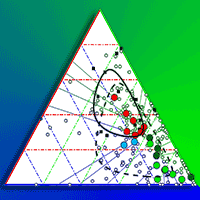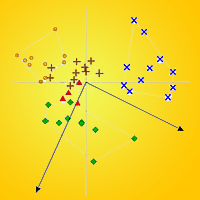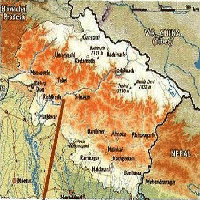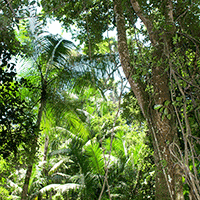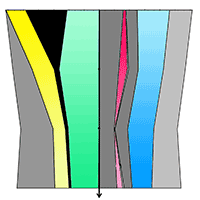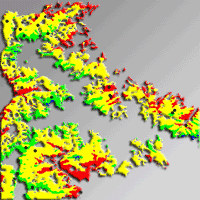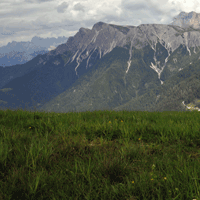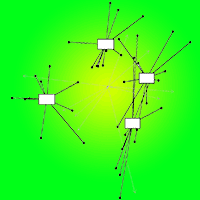
Influences of mature Pinus nigra plantations on the floristic-vegetational composition along an altitudinal gradient in the central Apennines, Italy
Marina Allegrezza (1) , Simone Pesaresi (1), Sandro Ballelli (2), Giulio Tesei (1), Cecilia Ottaviani (1)
iForest - Biogeosciences and Forestry, Volume 13, Issue 4, Pages 279-285 (2020)
doi: https://doi.org/10.3832/ifor3215-013
Published: Jul 03, 2020 - Copyright © 2020 SISEF
Research Articles
Abstract
Plantations of conifers are widespread in Europe, often occurring outside of their native range. Reduction in species richness linked to increases in altitude has been previously reported for natural forests, although there is a lack of specific studies for mature pine plantations in both the Apennines and Europe. The aim of this study was to quantify the long-term effects of the extensive Pinus nigra plantations carried out between 1900 and 1956 in protected areas on floristic richness, species composition, and ecological traits of the understorey vegetation. We compared 20 mature pine plantations selected along an altitudinal gradient (700-1700 m a.s.l.) with neighbouring deciduous natural forests dominated by Ostrya carpinifolia and Fagus sylvatica, which represent the most widespread forest types in the central Apennines. The results showed that floristic richness follows two distinct altitude trends in pine plantations and natural forests. A strong reduction in species richness with elevation was observed in the natural forests, as well as a consequent increase in the local contribution to beta diversity, with a turnover of the ecological traits of the species. Contrastingly, no significant changes in richness and beta diversity were found for pine plantations in the same altitude range. Indeed, mature pine plantations up to 1400-1500 m a.s.l. showed the presence of many heliophilous and thermophilous species that are usually distributed at lower elevation. We discuss how such pine plantations can mitigate the effect of increasing altitude which is usually observed in the natural forests, slowing down the typical diversification of the forest communities along the altitudinal gradient.
Keywords
Pinus nigra Plantations, Forest Origin, Richness, Beta-diversity, Altitudinal Gradient, Canopy Filter, Protected Areas, Apennines
Authors’ Info
Authors’ address
Simone Pesaresi 0000-0002-3913-4749
Giulio Tesei 0000-0002-8921-8262
Cecilia Ottaviani 0000-0002-7111-6233
Department of Agricultural, Food and Environmental Sciences, Polytechnic University of Marche, v. Brecce Bianche, I-60131 Ancona (Italy)
School of Environmental Sciences, University of Camerino, v. Pontoni 5, I-62032 Camerino, MC (Italy)
Corresponding author
Paper Info
Citation
Allegrezza M, Pesaresi S, Ballelli S, Tesei G, Ottaviani C (2020). Influences of mature Pinus nigra plantations on the floristic-vegetational composition along an altitudinal gradient in the central Apennines, Italy. iForest 13: 279-285. - doi: 10.3832/ifor3215-013
Academic Editor
Matteo Garbarino
Paper history
Received: Aug 09, 2019
Accepted: Apr 30, 2020
First online: Jul 03, 2020
Publication Date: Aug 31, 2020
Publication Time: 2.13 months
Copyright Information
© SISEF - The Italian Society of Silviculture and Forest Ecology 2020
Open Access
This article is distributed under the terms of the Creative Commons Attribution-Non Commercial 4.0 International (https://creativecommons.org/licenses/by-nc/4.0/), which permits unrestricted use, distribution, and reproduction in any medium, provided you give appropriate credit to the original author(s) and the source, provide a link to the Creative Commons license, and indicate if changes were made.
Web Metrics
Breakdown by View Type
Article Usage
Total Article Views: 39743
(from publication date up to now)
Breakdown by View Type
HTML Page Views: 33993
Abstract Page Views: 2819
PDF Downloads: 2219
Citation/Reference Downloads: 1
XML Downloads: 711
Web Metrics
Days since publication: 2009
Overall contacts: 39743
Avg. contacts per week: 138.48
Citation Metrics
Article Citations
Article citations are based on data periodically collected from the Clarivate Web of Science web site
(last update: Mar 2025)
Total number of cites (since 2020): 3
Average cites per year: 0.50
Publication Metrics
by Dimensions ©
Articles citing this article
List of the papers citing this article based on CrossRef Cited-by.
References
Notulae alla Checklist della flora vascolare italiana. Notula (2079) Goodyera repens (L.) [Notulae to the Checklist of the Italian vascular flora. Notula (2079) Goodyera repens (L.)]. Informatore Botanico Italiano 46 (2): 270-271. [in Italian]
Gscholar
La gestione dei rimboschimenti con pino nero [The management of black pine plantations]. Monti e Boschi XLIII (4): 27-29. [in Italian]
Gscholar
Indagini geobotaniche per il recupero del rimboschimento del Monte Conero (Italia centrale). [Geobotanical investigations for the restoration of the Monte Conero forest plantation (central Italy)]. Documents Phytosociologiques XVI: 387-425. [in Italian]
Gscholar
Quantifying the biodiversity value of tropical primary, secondary, and plantation forests. Proceedings of the National Academy of Sciences USA 104: 18555-18560.
CrossRef | Gscholar
An updated checklist of the vascular flora native to Italy. Plant Biosystems 152 (2): 179-303.
CrossRef | Gscholar
Plant communities of Italy: the vegetation prodrome. Plant Biosystems 148 (4): 728-814.
CrossRef | Gscholar
La vegetazione d’Italia [The vegetation of Italy]. Palombi and Partner S.r.l., Roma, Italy, pp. 540. [in Italian]
Gscholar
Pflanzen-soziologie [Plant sociology]. Springer, Berlin, Germany, pp. 330.
Gscholar
Zeigerwerte von pflanzen in Mitteleuropa [Indicator values of plants in Central Europe]. Scripta Geobotanica 18: 1-248. [in German]
Gscholar
Le stime di superficie 2005 - Prima parte. Inventario nazionale delle foreste e dei serbatoi forestali di carbonio [Area estimation 2005 - First part. National inventory of forest and carbon forest accumulations] (Tabacchi G, De Natale F, Di Cosmo L, Floris A, Gagliano C, Gasparini P, Genchi L, Scrinzi G, Tosi V eds). MiPAF - Corpo Forestale dello Stato - Ispettorato Generale, CRA -ISAFA, Trento, Italy. [in Italian]
Online | Gscholar
Fagus sylvatica L. recruitment across a fragmented Mediterranean landscape, importance of long distance effective dispersal, abiotic conditions and biotic interactions. Diversity and Distributions 13 (6): 799-807.
CrossRef | Gscholar
Conversion of pure pine and spruce forests into mixed forests in eastern Germany: some aspects of silvicultural strategy. In: “Management of mixed-species forest: Silviculture and economics” (Olsthoorn AFM, Bartelink HH, Gardiner JJ, Pretzsch H, Hekhuis HJ, Franc A eds). IBN scientific contributions 15, Institute for Forestry and Nature Research (IBN-DLO), Wageningen, Netherlands, pp. 208-218.
Online | Gscholar
La gestione dei rimboschimenti tra selvicoltura e arboricoltura da legno [The management of forest plantation between silviculture and wood arboriculture]. In: “Nuove frontiere nella gestione forestale” (Ciancio O ed). Accademia Italiana di Scienze Forestali, Firenze, Italy, pp. 117-129. [in Italian]
Gscholar
Vegetation dynamics in Pinus nigra Arnold subsp. nigra 100 years after reforestation: two case studies in the central Apennines. Plant Sociology 52: 79-94.
Gscholar
Bioindicazione attraverso le piante vascolari. Valori di indicazione secondo Ellenberg (Zeigerwerte) per le specie della Flora d’Italia [Biondication through vascular plants. Indication values according to Ellenberg (Zeigerwerte) for the flora species of Italy]. Braun-Blanquetia 39: 1-97. [in Italian]
Gscholar
Flora d’Italia [Flora of Italy]. Edagricole, Bologna, voll. 1-3. [in Italian]
Gscholar
Worldwide bioclimatic classification system. Global Geobotany 1: 1-634.
Gscholar
Twenty-year performance of Scotch, European black (Austrian), red, and jack pines in eastern Nebraska. Research Paper RM-267, USDA Forest Service, Rocky Mountain Forest and Range Experiment Station, Fort Collins, CO, USA, pp. 14.
Gscholar

